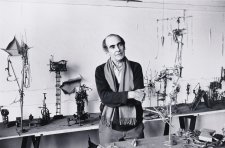Robert Klippel AO (1920–2001) is considered by some to be the most significant sculptor Australia has yet produced. As a child he was interested in making model planes and ships. This hobby became a profession after he joined the Royal Australian Navy in 1939: after four years at sea, he was assigned to the Naval Gunnery, where he was engaged in constructing model aircraft and ships designed to educate his fellow-servicemen in the recognition of enemy craft. After the war, he enrolled to study sculpture at East Sydney Technical College. In 1947 he went to London and continued his training at the Slade School of Art. His 'assemblages' – sculptures that combined mechanical objects with organic materials – attracted enthusiasm in Europe. After returning to Australia in 1950, Klippel took courses in welding and panel beating and expanded his experimentation with materials and form even further. He lived in New York for several years from the late 1950s and during this period began incorporating junk metal into his work. Back in Sydney from 1963, he moved to a house in Birchgrove, where he lived and worked for over 30 years. It was during this period that he reconnected with sculptor Rosemary Madigan, whom he'd met at art school in the late 1940s. Their relationship endured until the end of his life. Klippel died on his 81st birthday, at which point he was working with curator Deborah Edwards on the retrospective exhibition that was presented by the Art Gallery of New South Wales in 2002.







